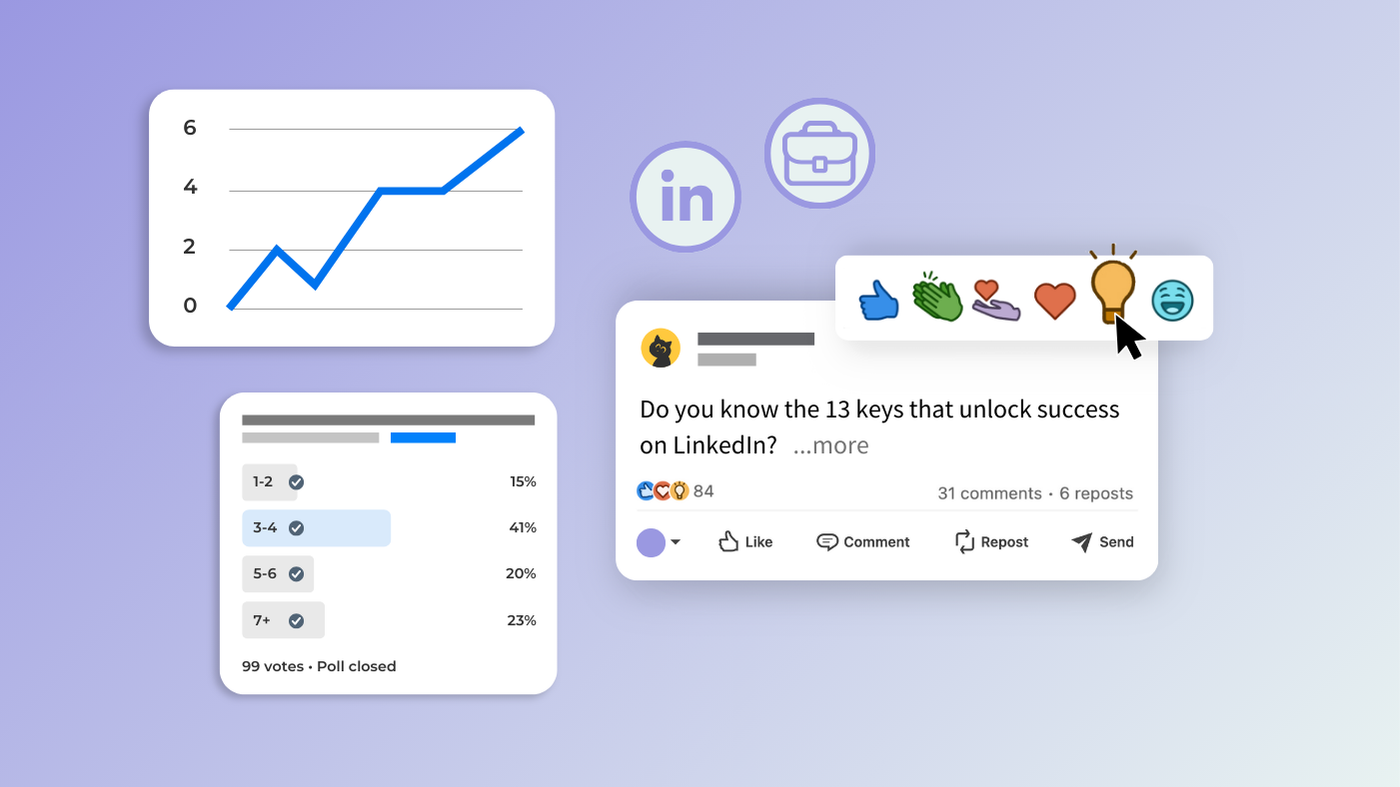There’s simply no better place to be than LinkedIn if your customers are businesses.
With over 1 billion members — including Fortune 500 executives, industry experts, and thought leaders — LinkedIn is the world’s premier professional social network and a B2B marketing goldmine.
In this guide, we’ll look at how this platform shapes your marketing efforts, and show you some best practices that will help you grow your brand and win more customers — including 13 tactics you can start using today.
Here are the key LinkedIn marketing topics we'll cover:
- Why is LinkedIn marketing important?
- Is LinkedIn Premium worth it?
- Who uses LinkedIn?
- LinkedIn content strategy (what to post and what NOT to post)
- How to track your performance with LinkedIn analytics
- 13 ways to make your LinkedIn stand out
To start, let's examine why LinkedIn is a worthwhile social media platform — especially for B2B businesses.
Why is LinkedIn marketing important?
There are four major reasons to consider starting or expanding your marketing efforts on LinkedIn:
- Access to a highly targeted audience of professionals and decision-makers, so you can effectively reach the right people for your business.
- Robust advertising tools and features, including sponsored content, InMail, and display ads, allowing you to showcase your products and services effectively.
- Strong platform for thought leadership, helping you build your brand through industry insights and expertise.
- Environment of credibility and trust, making it an ideal place to establish and nurture professional relationships.
The platform is almost tailor-made to support B2B marketing, helping you stand out as an expert in your field, reach highly targeted audiences, and develop strong community that can translate to client and partner relationships.
While LinkedIn is the place to B2B (it's even their advertising slogan), its ability to platform executives and employees as thought leaders can still be useful for B2C businesses and nonprofits to increase awareness of their brand.
Is LinkedIn Premium worth it?
With a basic, free LinkedIn account, you can set up and manage a company page alongside your personal page. You'll get access to the all the posting and community features, and you can establish an ads account to start running paid advertising.
LinkedIn also offers a few paid plans that enable advanced sales, marketing, and recruitment tools. These plans are known as LinkedIn Premium and LinkedIn Sales Navigator.
Here's the paid plan breakdown:
- LinkedIn Premium Career: As the name suggests, this plan is mainly targeted at job seekers. The $29.99 a month fee gives you unlimited access to LinkedIn Learning courses to boost your skills, profile insights (like who has viewed your profile), plus InMail credits, which let you reach out to LinkedIn members you aren’t connected with.
- LinkedIn Premium Business: This plan costs $59.99 a month and gives you access to everything in the Career plan, plus a custom button for your page and additional business insights.
- Premium Company Page: This newer feature is targeted at small businesses, offering custom CTA buttons, insights into Page visitors, testimonial display, ad credits, and more. The plan costs $99/month.
- LinkedIn Sales Navigator: There are three tiers of Sales Navigator — Core, Advanced, and Advanced Plus. Made specifically for sales outreach, these plans get you access to a comprehensive set of lead generation features, including advanced search filters, custom lists for lead scoring, and integration with your customer relationship management software. These plans start at $99.99 per month.
- LinkedIn Recruiter: There are three tiers of Recruiter plans — Recruiter Lite, made for small teams; Recruiter Professional Services, made for staffing firms; and Recruiter, made for enterprise companies. As the name suggests, this is for you if you’re looking to hire employees. Lite is $170/month, but the other two plans are much steeper at $895 and $1080.
Whether LinkedIn Premium is worth it depends on your situation.
- LinkedIn Premium Career might be worth it if you're actively looking for a job and would like to opportunity to connect with peers and potential mentors, or pitch yourself to you dream job's hiring team. LinkedIn Learning is also not too shabby — the instructors are vetted, so you can sharpen up key skills that will help you shine in interviews.
- LinkedIn Premium Business or a Premium Company Page might be worth it if if your business has a very active LinkedIn presence and you believe additional insights will help you tailor your content, target ads, and potentially generate leads. These plans help you approach your LinkedIn Company page more like a website, so if you use the platform frequently it might be worth the extra features and insights.
- LinkedIn Sales Navigator might be worth it if outbound sales is a core part of your strategy, you have a solid LinkedIn brand presence to back up your outreach, and you don't already have dedicated intelligence and CRM tools. These plans have advanced search features that help you search and track leads in your space, plus InMail credits for outreach. The more advanced tiers help you identify decision markers and uncover relationships in your network so that you can avoid cold outreach.
- Consider LinkedIn Recruiter if you need to staff up your business. While these plans are probably not worth it for the occasional hire, they can help you expedite the hiring process when you routinely have multiple positions to fill, or you're in a considerable growth stage and need more headcount ASAP.
Who uses LinkedIn?
LinkedIn has 1 billion users worldwide. Here are a few audience stats to help you put this massive network of professionals into context:
- The United States has more LinkedIn members than anywhere else in the world: 225 million.
- But there are LinkedIn members in 200 countries and territories across the world.
- 51% of LinkedIn members are aged 25-34.
- 56% of LinkedIn members are male, and 44% are female
- In total, 149 industries are represented on LinkedIn.
- The top 5 most represented industries on LinkedIn (in terms of number of members), are Real Estate, Medical Practice, Construction, Retail, and Management Consulting.
- 67 million companies and organizations have a Page on LinkedIn.
But how effective is LinkedIn at generating leads?
Most LinkedIn members log on to the platform specifically to network, further their careers, or grow their businesses. This means when you market your business on LinkedIn, you’re speaking to a captive audience.
But don’t think you can get away with posting anything as long as it’s business-related. While LinkedIn members tend to be receptive to marketing messages — and the platform is reporting record levels of engagement — LinkedIn members have very specific preferences when it comes to content.
Building a LinkedIn content strategy
As is the case on every other social media platform, you benefit from having a robust and varied content strategy that features different content types and formats.
Your LinkedIn content strategy is a blend of social media marketing and content marketing. Social media marketing emphasizes engagement — posting content that encourages likes, comments, and shares. On the other hand, content marketing focuses on delivering relevant content that meets your audience's needs, such as blog posts, how-to guides, ebooks, and case studies.
To succeed with LinkedIn marketing, you must combine these approaches to craft high-value, expertise-driven content that entertains and engages a knowledgeable, professional audience.
What to post on LinkedIn
So what type of content works well on LinkedIn? Here are some of the top content formats to try.
Need something to post right away? Check out our list of 20 LinkedIn post ideas for some inspiration you can immediately translate into content.
Zero-click content
Zero-click content on LinkedIn refers to posts that deliver all their value directly within the platform, without requiring users to click on external links to access more information. This type of content is designed to be self-contained, offering insights, tips, or information right in the post itself. Examples of zero-click content include:
- Text-based posts: Thought-provoking statements, industry insights, or short-form advice that doesn’t require additional context.
- Infographics: Visual summaries or data presentations that convey key points without needing an accompanying article.
- Carousels: Slide-style posts that allow you to share multiple images or pieces of information in a single, scrollable format.
- Polls: Interactive questions that encourage audience participation and discussion without linking to an external site.
- Short videos: Clips that provide valuable insights or tutorials directly within the feed.
While you may sacrifice clicks to external links, this approach usually results in richer interactions like comment threads and more followers. The immediate value you provide encourages deeper engagement, making your content stand out in users' feeds.
Beyond engagement, zero-click content positions you as a thought leader in your industry. By consistently sharing insights around a specific content pillar, you end up building a strong personal brand that resonates with a professional audience. This ups your credibility and makes it easier to attract clients who are looking for expertise in that particular area.
LinkedIn carousels
A LinkedIn carousel is a slideshow-style feature that lets you share multiple visuals in a single post. They're one of the most popular types of zero-click content on the platforms.
Whether it’s text-based slides or infographics, carousels make your content more engaging by adding a visual element that encourages interaction.
Carousels are like mini-presentations that let you share more information than a typical text post, and since you upload them as PDFs, they’re even downloadable for easy reference.
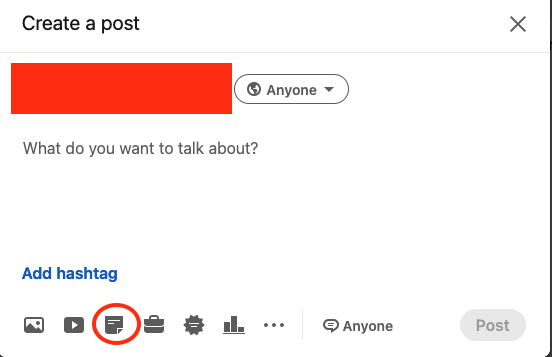
Whether you’re marketing for a B2B brand, or building your personal platform, carousels are a versatile tool to enhance your social content strategy. If you're advertising on LinkedIn, you can also create LinkedIn carousel ads, which give you more real estate for visuals and copy than a typical single-image ad.
LinkedIn video
LinkedIn has launched and subsequently retired a few video features since 2020, but they're not giving up on this format yet. In fact, LinkedIn is rolling out in-feed suggested video carousels to drive more engagement on video uploads. (That means they're probably prioritizing video in the algorithm.)

With short-form video leading the conversation on Instagram, TikTok, and YouTube, it's not hard to imagine it taking off on LinkedIn. The question remains whether the LinkedIn's professional audience wants to engage with this type of content.
You can upload videos up to 15 minutes long when uploading from desktop and 10 minutes long when uploading from the LinkedIn mobile app. This means you can test a variety of video lengths to see if short-form or long-form video works best for you.
You can also broadcast live videos. When you broadcast the video is automatically recorded and shared on your page, so your followers can see it even if they’re not around while you’re live. The catch is that you need to get verified before you can start broadcasting.
At any rate, if you already post educational content on other social media platforms, it's absolutely worth it to cross-post it to LinkedIn.
What NOT to post on LinkedIn?
There are two types of content you should avoid as much as possible on LinkedIn: posts with external links and engagement bait.
Posts with external links
Like any other social media network, it’s in LinkedIn’s best interest to keep its users on the platform for as long as possible. That's why LinkedIn’s algorithm punishes posts that contain external links. These posts might get fewer views, which translates to lower engagement.
 This is one major reason to prioritize zero-click content. But if you absolutely can’t avoid an external link, try one of these workarounds:
This is one major reason to prioritize zero-click content. But if you absolutely can’t avoid an external link, try one of these workarounds:
- Publish the post without the link, then press edit and add the link in
- Add the link as a first comment on the post
Engagement bait
LinkedIn’s growing popularity and effectiveness for lead generation has inspired "growth hackers" to find ways to cheat the algorithm and boost engagement.
LinkedIn is onto this type of content — it won't recommend content that’s designed purely to elicit a response.
In particular, LinkedIn’s algorithm punishes:
- Posts that ask followers to respond with a specific reaction.
- Emoji or reaction polls: If you want to run a poll, use the dedicated LinkedIn poll feature (you can schedule them to auto-publish with Loomly!).
- Political content: While this isn’t actively penalized, LinkedIn allows its members to opt out of seeing it.
The most important LinkedIn metrics to track
There are tons of metrics you can track in LinkedIn, whether your and individual or a business with a company page. These include the usuals, like engagement metrics, and some stand-out extras, like in-depth follower and visitor information.
 You can learn more about how to find your LinkedIn analytics and how to approach your platform audits in our guide to LinkedIn analytics. For now, let's cover the top seven metrics that anyone trying to grow their account should focus on:
You can learn more about how to find your LinkedIn analytics and how to approach your platform audits in our guide to LinkedIn analytics. For now, let's cover the top seven metrics that anyone trying to grow their account should focus on:
- Impressions: Number of times your content is displayed, showing its reach and exposure.
- Click-through rate (CTR): Percentage of users who click on your content, indicating its appeal and relevance.
- Engagement rate: Level of interaction with your content, including likes, comments, shares, and clicks.
- Followers: Size of your audience, reflecting interest in your brand or profile.
- Follower demographics: Data on your audience's location, industry, job title, and more for targeted content.
- Profile visits: Number of users viewing your profile, signaling interest and potential leads.
- Conversion tracking: Measures user actions after engaging with your content, helping track ROI and lead generation.
13 ways to make your LinkedIn stand out
So far, we’ve talked about the audience and what captures their attention (and makes them click the Ignore button). But how do you make the most of your LinkedIn presence?
Here are our top tips.
1. Complete your company page
You should create your company page for three reasons:
- It’s where prospective customers can learn more about your brand
- You’ll need it in order to run LinkedIn ads
- Let’s face it — it makes you look more professional and authoritative when LinkedIn members look you up
You should keep your LinkedIn company page consistent with the rest of your social media presence, otherwise visitors might not realize it’s you.

Use the same banner and logo on all your socials — this should have a ratio of 5.9:1. For instance, 2360 X 400 pixels — and try to keep the language consistent, too. While LinkedIn is a professional network, that’s not a license to be boring or forgettable.
The company innocent drinks, for instance, makes it a point to be as approachable on LinkedIn as it is on Twitter or Facebook.
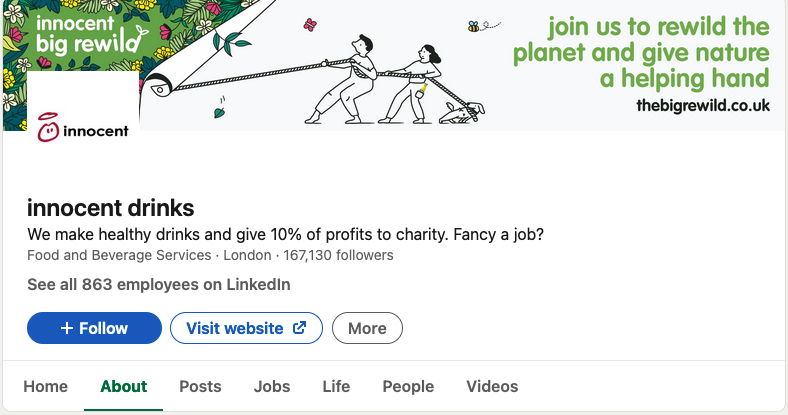
You should also fill out the About section of your profile as comprehensively as possible.
Explain what you do in plain language so it’s easier for prospective customers to understand, and use keywords and phrases they’re likely to use when searching for a product or service like yours.
Don’t forget to add a link to your website — and a link to your LinkedIn page on your website. This will likely give your search rankings a boost, which is always helpful.
2. Involve your employees
While you definitely need a LinkedIn company page, posts from individual profiles usually get more engagement.
For this reason, your staff — not just your C-suite, but employees at all levels — should be an integral part of your LinkedIn marketing strategy.
There are two key ways you can involve your staff in your LinkedIn marketing efforts.
Thought leadership
Brands that are successful on LinkedIn invariably have executives who are very active on the platform.
Virgin Group CEO Richard Branson, for instance, regularly shares his hard-won knowledge with his 19.7 + million followers. Similarly, Ellevest CEO Sallie Krawcheck is always striving to educate her 2.7+ million followers so they can get better control of their financial health.
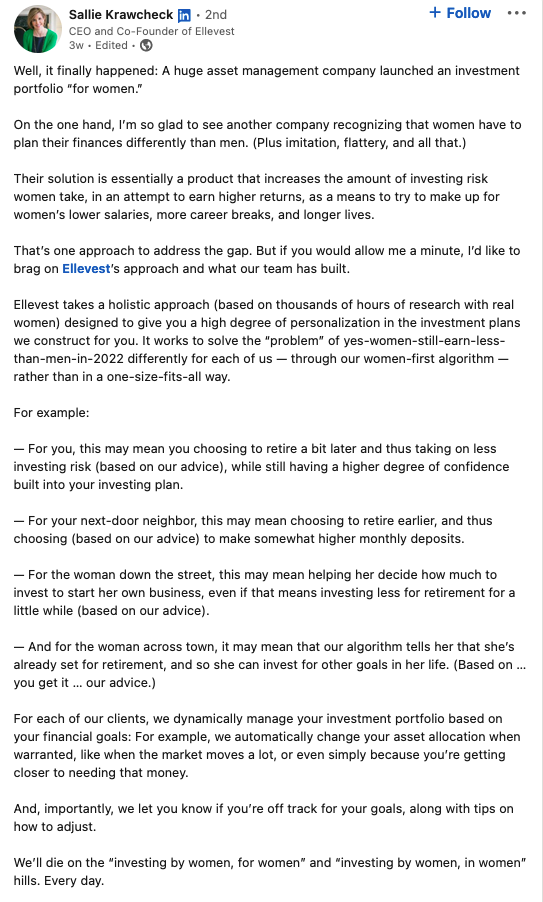
When executives showcase their knowledge and expertise, they position themselves as authorities in their fields. And if your brand’s leaders come across as people who know what they’re talking about, your company will appear more trustworthy to prospective customers — a safe pair of hands.
Employee advocacy
The best publicity your brand can get is happy employees who are invested in your success. Brands with engaged staff get eight times more views on their company pages, four times more followers, and four times more job applications.
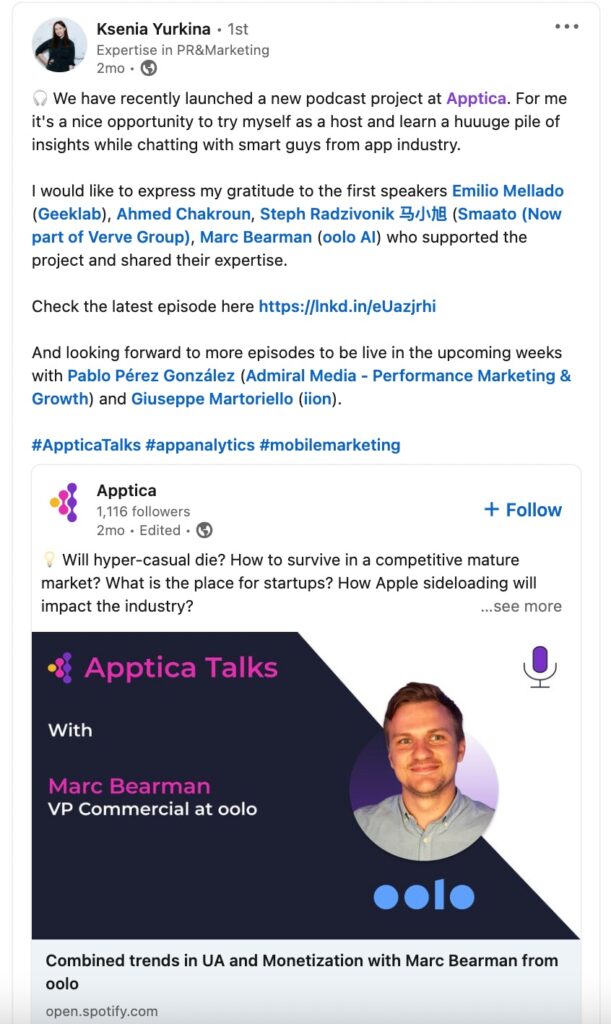
You can get staff involved in your LinkedIn marketing campaigns in several ways:
- Share their perspectives: They could share their opinion about an industry topic, talk about their experience at an event, or even talk about their job and career story.
- Spotlight their success: Give your employees a shout-out to show your appreciation, or simply reshare their content. LinkedIn will let you know when your employees' posts are trending, so you can repost them for more engagement.
3. Optimize your LinkedIn profile and company page for native search and search engines
To harness the power of LinkedIn, optimizing your profile and company page for search engines is essential. Start by incorporating relevant keywords throughout your profile and company page, including in your headline, summary, experience, and skills sections. This will increase your visibility in search results when users look for professionals or companies in your industry.
Additionally, ensure that your profile and page have a clear and compelling description of your expertise, products, and services. Include links to your website and other relevant online platforms.
Lastly, regularly update your profile and business page with fresh content to maintain an active and engaging online presence. This could include industry articles, blog posts, or company updates.
4. Show up consistently
We shouldn’t have to say this, but you can’t succeed at social media marketing unless you’re consistent. For your followers to trust you and, eventually, buy from you, you need to build a relationship with them.
LinkedIn content tends to have a longer lifespan compared to social media networks like Twitter, which means you can get away with posting less frequently. Experts recommend posting two to three times a week on personal profiles and once a week on your company page.
More importantly, engage, engage, and then engage some more.
Replying promptly to comments makes your posts more visible, which means more people will see them, react, and comment.
You should also spend time engaging with other people’s content, without being salesy. Posting meaningful comments that contribute to the discussion will help you build connections and grow your network.
5. Connect with decision-makers in your industry
To fully leverage the power of LinkedIn, it’s crucial to connect with decision-makers in your industry. Here’s how you can do it:
- Start by identifying key individuals with your target market or organizations.
- Once you’ve done that, use LinkedIn’s advanced search and filters to narrow down your search and find relevant professionals.
- Then send personalized connection requests, highlighting shared interests or mutual connections and explaining how you can provide value to them.
- Finally, consistently engage with their content by liking, commenting, and sharing, demonstrating your knowledge and interest in their industry.
By building a network of decision-makers, you gain access to valuable insights, potential collaborations, and business opportunities, enhancing your chances of success on the platform and beyond.
6. Find highly targeted leads and connections
LinkedIn offers powerful tools for finding highly targeted leads and connections. So leverage its advanced search functionality to narrow down your search criteria based on industry, job title, location, and other relevant filters. This enables you to identify individuals who match your target audience or potential business partners.
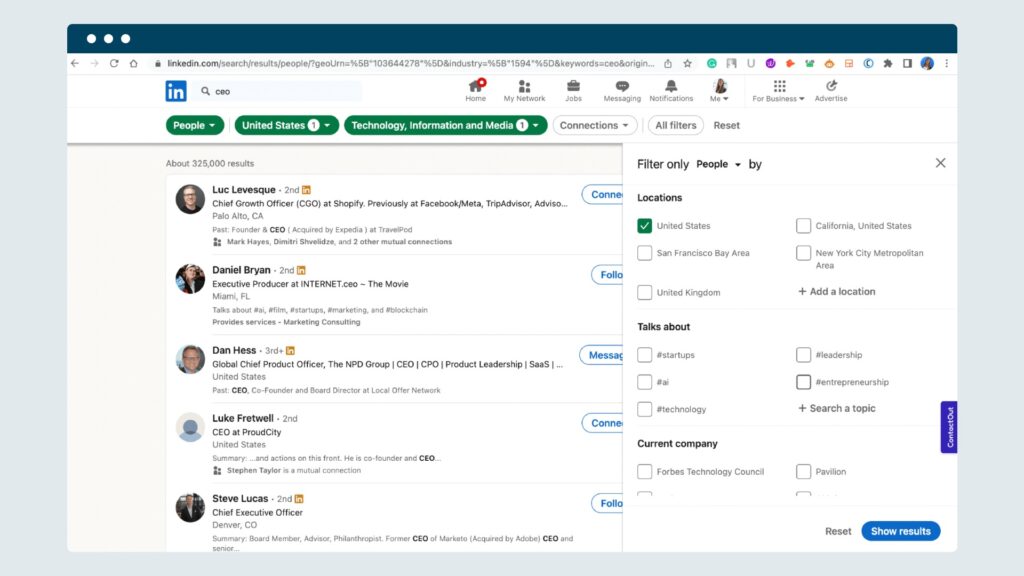
Once you have identified prospects, reach out to them with personalized messages or connection requests, highlighting how your products or services can benefit them.
7. Use hashtags
LinkedIn lets members follow hashtags, so using them in your posts will make it easier for the people you’re targeting to find your content.
For best results:
- Add hashtags at the end of your posts
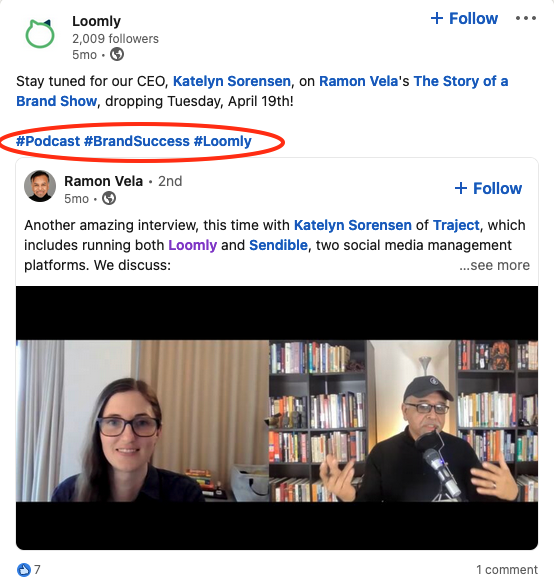
- Stick to three hashtags per post, at most
- If there are several relevant hashtags you could choose from, pick the most popular. LinkedIn shows you how many followers a particular hashtag has

Or, for a more user-friendly alternative, use Loomly Hashtag Suggestions. This will show you relevant and trending hashtags to consider and lets you add them to your post at the click of a button.
8. Check out who has viewed your LinkedIn profile
One of the valuable features LinkedIn offers is the ability to see who’s viewed your profile. Checking out who’s viewed your LinkedIn profile can provide valuable opportunities for engagement. This way, you can identify potential leads, clients, or collaborators. It allows you to reach out to them with personalized messages, expressing your interest and exploring potential connections or business opportunities.
What’s more, understanding who is viewing your profile can help you gauge the effectiveness of your networking efforts and adjust your strategy accordingly.
9. Grow your email marketing list
Newsletters on LinkedIn allow you to share valuable, serialized content directly with your network and followers. This is a great way to post more in-depth content that drives credibility and trust, and converts more readers into followers.
 Sign up for Loomly's LinkedIn newsletter
Sign up for Loomly's LinkedIn newsletter
If you already have an email newsletter, this tactic is a no-brainer. Simply republish your email content as an article for your LinkedIn newsletter and start building an additional subscriber list. You can also interact with readers via the post comments — a benefit you don't get with regular email.
10. Join targeted LinkedIn groups
Joining targeted LinkedIn groups is a strategic way to expand your professional network and engage with individuals who share common interests or are part of your target audience.
Start by searching for relevant groups based on your industry, profession, or specific topics of interest. Join groups that align with your marketing goals and actively participate by sharing valuable insights, asking questions, and engaging in discussions.
11. Avoid hard sells — build relationships instead
When using LinkedIn for marketing purposes, it’s important to avoid hard sells and focus on building relationships instead. LinkedIn is a professional networking platform where individuals seek meaningful connections and valuable insights.
So instead of pushing sales pitches, engage with your audience and cultivate relationships by actively participating in conversations, responding to comments, and offering helpful advice.
12. Experiment with LinkedIn Ads
Investing in LinkedIn ads is worthwhile because you get access to a highly targeted and engaged audience, including decision-makers, professionals, and industry leaders. Advanced targeting options — such as job title, company size, and industry — allow you to reach the right people with precision, increasing the likelihood of conversions. And because of its B2B focus, LinkedIn users are more receptive to business-related content, making ads particularly effective for lead generation, B2B marketing, and driving qualified traffic.
LinkedIn ads can be more expensive than those on other social media platforms, but the cost reflects the value of reaching a more specific, high-intent audience. Higher conversion rates, better-quality leads, and increased visibility within a professional network often result in a greater return on investment (ROI).
13. Evaluate your performance
LinkedIn Analytics provides you with a wealth of information about your company page, which you can use to tweak your strategy and get better results.
Some of the key metrics you can look at include:
- How individual posts have performed — helpful for optimizing your content strategy
- Page visitor and follower demographics
- How your page’s performance compares to that of your competitors
- The results of employee advocacy efforts
Loomly’s Advanced Analytics can also help you get a deeper understanding of how well you’re doing on LinkedIn.
Wrapping up: How to market your business on LinkedIn
With a worldwide network of hundreds of millions of professionals and sky-high engagement, there’s no better place than LinkedIn to establish your authority, make valuable connections, and find top talent that helps you grow.
The key is to use it the right way:
- Optimize your profile so it’s easy for members to find you and understand who you are and what you do.
- Share helpful content consistently. Native documents and videos do best. Steer clear of engagement bait and content with external links, as LinkedIn doesn’t like it when you send users away from the site.
- Experiment with ads and other paid features.
- Evaluate your performance regularly and use your findings to make your content more effective.
- Most importantly, remember that LinkedIn is, first and foremost, about making connections, and that means your efforts should be two-way conversations.
